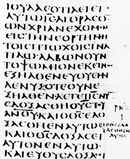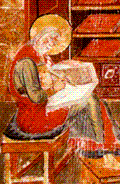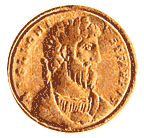"Word of God"
A Work in Progress
“Do not add to these words lest He reprove you and you be proved a liar.”
– Proverbs 30.6.
There are many Christian bibles. Several hundred in fact (and this number excludes the thousand-plus foreign language editions). Every group that has ever claimed the title ‘Christian’, from gnostic sects of the second century, through countless ‘heresies’ of the Middle Ages, to Mormons of the twentieth century, has had recourse to its own version of the holy testament.
This fine tuning of God’s word, which began at the very inception of Christianity, continues even in our own day. Though this plethora of bibles share a common core, many contain material omitted by others, and vice versa. Even where the content is ostensibly the same, verses have been removed or added, words transposed, rearranged or rephrased. Evidently, God, as the ultimate ‘author’ is endlessly searching for that fine nuance, that pithy turn of phrase.
What is not apparent, when we pick up the holy book, is the extensive editing that has prepared that volume for public consumption, and this editing applies just as much to the central story and its main characters as to any subsequent tinkering – more so, in fact. In the first two centuries of the Christian era, when a ‘Bible’ as such did not exist and the proselytes of the new faith were scouring the Jewish scriptures for confirmation of their heresy, many scribes turned their hand to ‘gospel’ writing. These publications were severely ‘limited editions’, painstakingly written by hand. Often untitled and unsigned these texts passed from hand to hand, in time acquiring the authority and aura of an antique and blurring the distinction between fiction, history and scripture.
Director’s Cut
“The evangelists were inventors – not historians.”
– Porphyry, Against the Christians, c. 280 AD.
It was well into the 2nd century before a number of these ‘testimonies’ were collected together and bound into a single volume. From the mass of available material ecclesiastical editors selected what would and what would not be included in the Good Book. But of course different editors made different choices.
Search the Bible in vain for the gospels of Thomas, Matthaias or the ‘The Twelve’; for the Acts of Andrew or Acts of John; for the Epistle of Barnabas, the Didache; for the Shepherd of Hermas or the Apocalypse of Peter. Yet for the first two centuries of Christianity all of these were holy scripture, the revealed Word of God.
On the other hand rejected by the early church fathers were Paul’s letter to Philemon, the second and third letters of John, the second letter of Peter and the General Epistle of Jude, all part of the canon after Christianity became the state religion!
Clearly the Big Guy had had a major rethink. Roman bibles after the fourth century hedged their bets and included ‘doubtful’ and previously rejected material at the end as ‘Apocrypha’ (‘hidden’). Clearly this was God’s rough draft, not really meant for publication. Luther kept the apocrypha in his bible whereas Calvin and most other Protestant reformers excluded them.
To regard this wholesale editorial selection and censorship, and the rewriting which accompanied it, as a function purely of the human mind, influenced by considerations of ambition and wealth, power and politics, is, of course, to lose sight of the hand of god; the divine, beavering away in overdrive in central Europe and the eastern Mediterranean centuries ago!
Keeping Current
In truth, if scripture were not to be regularly revised no one alive would understand a word of it. Through the centuries, vocabulary, word usage, syntax and grammar continuously change. The ‘Great Bible’ of 1539 was the first English ‘national’ bible, appearing after the break with the Pope and his Latin Vulgate. Though written in ‘English’, little of it would be intelligible to the twenty first century English speaker. A tad more digestible is the ‘Authorised’ King James Version, the earliest bible to introduce the numbering of sentences. Its magisterial tone, with all its ‘begats’ and ‘art thous’, merely ossifies the appealing authority and grandiose language of monarchical England in 1611. It was followed by a series of subsequent revisions including the Revised Version of 1885, the American Standard Version of 1901, the Revised Standard Version of 1952, etc., etc.
The revisionist claim has always been made of ‘capturing the essential truth’ of the Greek and Hebrew originals – a neat trick when one considers that the originals were actually written entirely in capitals and without the benefit of punctuation or even spaces between words. Because of the high cost of vellum many words were truncated or abbreviated to squeeze more in – but at a cost of even greater ambiguity. As the original scrolls were copied, generation by generation, marginal notes, added by later clerics as personal interpretations or amplifications of obscure points, were written into the body of scripture itself. In this centuries’ long process of revision, many gospels fell completely by the wayside, not even making the apocrypha and known to us today only by chance survival.
Deceptive Arrangement
For the most part, each of the two ‘testaments’ of the Bible is made up of chapters, grandly styled ‘books’, with each ‘book’ set out in groups of paragraphs, confusingly called ‘chapters.’ Some ‘books’ are very brief indeed. The book of Ruth, for example, is barely two pages, 2,578 words in fact. The longest, Jeremiah, at 42,659 words, would make a pamphlet of reasonable length. Authorship of the Old Testament was largely a 5th/6th century BC affair (with the ‘Chronicler’ not writing until the mid-fourth century); authorship of the New Testament primarily occurred in the 2nd century AD. With all the revisions and re-writes the effort involved a good many people. Arguably, some of them wrote inspiring words – but in no sense is that the same as the words being inspired by a deity. The total compendium, though impressive and at times entertaining, makes torturous reading.
The ‘books’ are arranged in a particular order, one that appears to be an unfolding story – from Jews to Jesus, from Jesus to Church, from birth of the Messiah to a vision of the Day of Judgement yet to come.
It appears to be chronological. It is not.
The order is largely reversed. Exodus was written before Genesis. ‘Prophesies’ written after events are reassigned to an earlier authorship in order to establish their veracity. An ancient and heroic ‘history’ reflects the contingencies of a much later time. The final book, the ‘Revelation of St. John’ is the earliest, not the latest, part of the New Testament, save for the correspondence of St Paul, which itself pre-dates all the gospels – and not one of the favoured gospels took on their present form before 150 AD.
Similar liberties have been taken within the individual books themselves, with later additions used to preface or addend the original work. Mark is earlier than Matthew, yet its ending has been extended by borrowings from the later work. The ‘Revelation of St. John’, in its original draft a composite of several Jewish apocalyptic dramas, was later Christianized by a preface of ‘letters to the churches of Asia’.
No more true is this process of time-reversal or ‘back projection’ than of the life and times of the Jesus character himself, who began his existence as a celestial superhero, acquired an earthly death; subsequently was given an adulthood; and completed his career with a spectacular nativity!
The Church, in the sense of organisation, authority, assets and membership preceded rather than followed the justifying doctrine. As the organisation and its needs changed so the ‘testament of god’ adapted accordingly. Shuffling the confused jigsaw of stories back into the chronology of authorship proves very revealing.
Business Begets Bibliolatry
What becomes very obvious when the parts of the book are rearranged into the order in which they were written is that the story grew with the telling. For example, if we look at the central mystery of Christianity, the ‘Resurrection’, we find that in Mark’s gospel (the earliest) the visitors to the tomb find a sitting figure, ‘a young man in a white robe’ (Mark 16.5). He could have been anybody. Thirty years later the story is rather different: we can choose between the sudden appearance of ‘two men’, standing in ‘shining garments’ (Luke 24.4); or ‘a great earthquake: for the angel of the Lord descended from heaven … His countenance was like lightning, and his raiment white as snow’ (Matthew 28.2,3).
Often an anachronism within the gospels provides a clue to the true authorship of the text. For example, all three synoptic gospels have Jesus use the phrase ‘take up his cross’. This is Mark:
“And when he had called the people unto him with his disciples also, he said unto them, Whosoever will come after me, let him deny himself, and take up his cross, and follow me.”
– Mark 8.34.
Matthew (16.4) and Luke (9.23) use almost identical words.
What’s ‘wrong’ here is that the crucifixion has not yet happened – the phrase belongs to a Christian Church a century or more into the future!
Each and every verse of the Bible is a testament to the needs and purposes of a particular time or place, whether to restate a gem of folk wisdom, upstage a rival story, assimilate a popular pagan myth, quash an opponent’s arguments or serve a current political purpose. Necessarily, and unavoidably, the compendium is rife with contradictions and inconsistencies.
Which (if either!) is correct, for example, in the fishy bread story?
“And when he had taken the five loaves and the two fishes, he looked up to heaven, and blessed, and brake the loaves, and gave them to his disciples to set before them; and the two fishes divided he among them all. And they did all eat, and were filled. And they took up twelve baskets full of the fragments, and of the fishes. And they that did eat of the loaves were about five thousand men.”
“And he commanded the people to sit down on the ground: and he took the seven loaves, and gave thanks, and brake, and gave to his disciples to set before them; and they did set them before the people. And they had a few small fishes: and he blessed, and commanded to set them also before them. So they did eat, and were filled: and they took up of the broken meat that was left seven baskets. And they that had eaten were about four thousand: and he sent them away.”
The first quotation is from Mark 6.41,44: the second only a page or so later from Mark 8.6,9!
Did Jesus go ‘immediately’ into the desert after baptism, as Mark tells us:
“And immediately the Spirit drove him into the wilderness. And he was there in the wilderness forty days, tempted of Satan; and was with the wild beasts; and the angels ministered unto him.” (Mark 1.12,13)
Or did he take himself off to a wedding as John would have it?
“And John bare record, saying, I saw the Spirit descending from heaven like a dove, and it abode upon him… The day following Jesus would go forth into Galilee, and find Phillip… And the third day there was a marriage in Cana of Galilee; and the mother of Jesus was there: And both Jesus was called, and his disciples, to the marriage.” (John 1.32;43: 2.1.2)
Was Mark correct when he quoted Jesus that there would be ‘no signs’:
“And he sighed deeply in his spirit, and saith, Why doth this generation seek after a sign? verily I say unto you, There shall no sign be given unto this generation.” (Mark 8.12)
Or was John nearer the truth when he says:
“And many other signs truly did Jesus in the presence of his disciples, which are not written in this book.” (John 20.30)
Creationism
By a convoluted process of interpolation, accretion and redaction, the whole compendium of fables and fancy was brought into being. The four Gospels had a precedent in the ‘sayings of Jesus,’ epithets of wisdom attached to a shadowy Christ figure. Progressively anthropomorphized into a human figure, a series of anecdotes, ‘reminiscences’ and stories were attached to his name.
What follows is a retracing of this great work of fiction, this history of a fake history; not the legend of a birth but the birth of a legend.
Where Did They Get Their Ideas From?
Apollonius of Tyana.
Apollonius was born during the reign of Augustus Caesar in the year 3 BC at Tyana, in Asia Minor. His parents were wealthy and Apollonius was educated first at Tarsus, and then at the Temple of Asclepius at Aegae. At sixteen he became an adherent of Pythagoras and a wandering ascetic. In his desire for knowledge he travelled to most of the known world. According to legend he performed miracles wherever he went and was listened to by adoring crowds.
Apollonius claimed to receive revelations from the gods. In truth, he probably learnt techniques of mystical deception from the Brahmins of India and the Magi of Babylon. In Ephesus he correctly warned of a plague and also claimed to have had a vision of the assassination of the Emperor Domitian. In Rome he supposedly brought the daughter of a consul back to life. Nero apparently expelled him from the city but Vespasian, Titus and Nerva all sought his advice. Hadrian collected his letters and writings. The great Emperor-philosopher Marcus Aurelius admitted that he owed his philosophy to Apollonius:
“From Apollonius I have learned freedom of will and understanding, steadiness of purpose, and to look to nothing else, not even for a moment, except to reason.”
Apollonius’s neo-Pythagorean philosophy embraced the sharing of goods, a condemnation of cruelty, and compassion for his fellowman. He taught in many of the centres of learning of the Greco-Roman world. Stories about him abounded, such as when in his mother’s womb, his mother was forewarned by an Egyptian god of her portentous off-spring. He reputed lived to be one hundred years. His followers claimed he was taken up into heaven. In Tyana a temple was built and dedicated to him, and statues of him resided in other temples.
Julia Domna, the wife of Emperor Septimius Severus, commissioned the philosopher Philostratus to write the biography of Apollonius, using the notebooks kept by Damis, a lifelong companion of the great sage. This book appeared in 210 AD.
But by the 4th century an established Christianity began attacking Apollonius as a charlatan, a black magician, and the anti-Christ. The Church was, after all, basing its claims of Jesus’ divinity upon the miracles that he is said to have performed – but Apollonius performed the same miracles earlier and called them not miracles but expressions of natural law!
Sources:
J. Paterson Smyth, How We Got Our Bible (Sampson Low, Marston, 1930)
Dan Cohn-Sherbok, The Crucified Jew (Harper Collins,1992)
Henry Hart Milman, The History of the Jews (Everyman, 1939)
Josephus, The Jewish War (Penguin, 1959)
Leslie Houlden (Ed.), Judaism & Christianity (Routledge, 1988)
Karen Armstrong, A History of Jerusalem (Harper Collins, 1999)
Jonathan N. Tubb, Canaanites (British Museum Press, 1998)
Norman Cantor, The Sacred Chain – A History of the Jews (Harper Collins, 1994)

Lies
“The Law of God? Look at it, it’s a pack of lies from the lying pen of Scribes.”
– Jeremiah, 8.8.
False Accreditation
“Every one knows that the Evangeliums were written neither by Jesus nor his apostles, but long after their time by some unknown persons, who, judging well that they would hardly be believed when telling of things they had not seen themselves, headed their narratives with the names of the apostles or of disciples contemporaneous with the latter.“
– Bishop Fauste (Manichean heretic, 3rd century AD)
“Worst of both worlds”
“If anyone should wish to know the truth with respect to you Christians, he will find your impiety to be made up partly of the Jewish audacity, and partly of the indifference and confusion of the Gentiles, and that you have put together not the best, but the worst characteristics of them both.”
– Emperor Julian (361-363
Inerrant?
“When they raised their eyes and took a look, why, here was a caravan of Ishmaelites that was coming from Gilead, and their camels were carrying labdanum and balsam and resinous bark, on their way to take it down to Egypt.”
– Genesis 37.25
The Old Testament reference is to Joseph, supposedly in Egypt about 1700 BC. The problem is that camels are unrecorded in Egypt until the 7th century BC, when they probably arrived from the Arabian Gulf area.
Fake History
“The first books of the Bible were written … during the period of the Babylonian Exile in the sixth century BC … The trauma of the Exile created the need to construct and articulate a comprehensive historical past …”
– Magnus Magnusson (The Archaeology of the Bible Lands-BC, p40)

Getting Better All The Time!
A page from “Gospel of St John” (Codex Sinaiticus). The copyist adds a new bit in the margin at verse 13. A later scribe will move the addition into the main body.

The Codex Sinaiticus, contains the earliest complete copy of the New Testament and is dated to around 350 AD. It may possibly be one of the fifty copies commissioned by Emperor Constantine.
Interestingly, Sinaiticus includes the non-canonical Epistle of Barnabas and the Shepherd of Hermas.
A paleographical study in 1938 found that the text had undergone a number of “corrections“.
Fabrication
“The gospel story is an artificial, non-historical work. It has been fabricated from source materials that can be identified and traced to their incorporation in the gospels. There is not a particle of hard evidence that ‘Jesus of Nazareth’ ever existed.”
– Harold Leidner (The Fabrication of the Christ Myth)
Different Story
“The opening chapter of the book of Judges presents a markedly different account of the Israelite occupation from that found in the book of Joshua …
The account in Judges reveals that … the Israelites settled alongside the indigenous inhabitants.
The newcomers did not attempt to expel or exterminate the natives.”
– J. R. Porter (The Illustrated Guide to the Bible, p73)
‘Son of God?’
This description applies to many different persons in Old Testament scripture –
• Angels (Job 38.7);
• Kings of Israel (2 Sam. 7.14);
• Israel as a whole (Hos. 11.1);
• Righteous Persons (Wis. of Sol. 2.15)
– Take Your Pick!

Puerile God
“If ye will not give glory unto my name saith the LORD … I will spread dung upon your faces.”
– Malachi 2.2,3.

“Hmm … perhaps an extra miracle might be useful at this point…”


